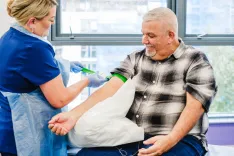
How do you check oxygen levels in blood?
Measuring oxygen levels in your blood is a quick and simple way to assess how well your body is distributing oxygen to your tissues and organs. Blood oxygen levels can provide vital clues about your respiratory and circulatory health and in some cases, even alert you to underlying health conditions before symptoms become noticeable.
So, how exactly are oxygen levels checked? What’s considered a normal range? And what might low or high blood oxygen levels mean for your health?
Here, we explore how blood oxygen is measured, what can affect your results and when it might be helpful to have a test.
What is blood oxygen?
Blood oxygen refers to the amount of oxygen carried by your red blood cells. Once you breathe in, oxygen enters your lungs and passes into your bloodstream. From there, it binds to haemoglobin in red blood cells and is transported around the body to support everything from brain function to cell repair.
Maintaining the right level of oxygen in your blood is essential. If your blood oxygen levels are too low, your body may struggle to function properly. In some cases, it could point to a health condition that needs further investigation or treatment.
How are blood oxygen levels measured?
There are two main ways to measure blood oxygen levels:
Pulse oximetry This is the most common and straightforward method. It uses a small clip-like device called a pulse oximeter, which is usually placed on your fingertip. The device shines a light through your skin to estimate how much oxygen is in your blood and gives you a reading in just a few seconds.
It’s completely painless and can be used at home, at a clinic or during a check-up. Your result is shown as a percentage, often labelled as SpO?.
Arterial blood gas test (ABG) A blood gas test gives a more in-depth look at how well your lungs are working. It involves taking a small sample of blood from an artery, usually at the wrist, and measuring the oxygen levels, as well as carbon dioxide and other markers of how well your body is keeping things balanced.
Because it’s a more detailed test, it’s usually only done in hospitals when doctors need a clearer picture of what’s going on with your breathing or overall health. This test is usually undertaken in an acute setting, usually when someone is very unwell.
What is a normal blood oxygen level?
Normal blood oxygen levels can vary slightly depending on the method of measurement:
-
Pulse oximetry: A healthy reading is typically between 95% and 100%. Levels under 92% may be considered low and could require further investigation.
-
Arterial blood gas: A normal level is usually between 75 and 100 mmHg. Levels below 60 mmHg may indicate that oxygen therapy is needed.
It’s important to note that “normal” can vary from person to person. Some people with long-term respiratory conditions may naturally have lower readings that are normal for them.
What can affect your blood oxygen levels?
Several factors can affect how much oxygen is in your blood, including:
-
Lung conditions such as asthma, COPD or pneumonia
-
Heart problems that impact circulation
-
High altitudes, where the amount of oxygen in the air is lower
-
Anaemia, where you have fewer red blood cells to carry oxygen
-
Smoking, which can reduce the lungs’ efficiency
-
Sleep apnoea, which can cause oxygen levels to drop overnight
If your blood oxygen levels drop suddenly or consistently fall below normal, it may be a sign that your body isn’t getting the oxygen it needs.
What are the symptoms of low blood oxygen?
Low blood oxygen, also known as hypoxaemia, doesn’t always cause symptoms straight away, which is why testing can be so useful. When symptoms do appear, they may include:
-
Shortness of breath
-
Rapid breathing
-
Confusion or difficulty concentrating
-
Headaches
-
Chest pain
-
Bluish tint to lips, skin or fingertips
If you’re experiencing these symptoms, particularly if they come on suddenly or are getting worse, you should seek medical advice as soon as possible.
Who might need an oxygen saturation test?
An oxygen saturation test may be recommended or helpful for:
-
People with chronic lung conditions like asthma, COPD or pulmonary fibrosis
-
Those with heart conditions that affect circulation
-
People experiencing unexplained breathlessness or fatigue
-
Individuals recovering from COVID-19 or other respiratory infections
-
Anyone living at high altitude for extended periods
-
People who snore heavily or are being monitored for sleep apnoea
Regular monitoring of oxygen saturation levels may also be part of ongoing care for those with known health conditions, particularly if they are using oxygen therapy.
Can you check your oxygen levels at home?
Yes, you can check your oxygen levels at home using a pulse oximeter. These small, battery-powered devices are widely available and simple to use. They’re often used by people managing long-term respiratory conditions or recovering from illness.
To get the most accurate reading, it’s best to:
-
Sit still and rest for a few minutes before taking a reading
-
Warm your hands if they’re cold
-
Avoid wearing nail polish or artificial nails
-
Keep your hand still during the test
While pulse oximeters are useful tools, they don’t replace a medical diagnosis. If your readings are consistently low or you’re experiencing symptoms, speak to a healthcare professional.
When should you speak to a doctor?
If your blood oxygen levels fall below 92% on a pulse oximeter, particularly if you’re also feeling unwell, you should speak to a doctor. It’s especially important to get advice if you have an existing lung or heart condition.
Similarly, if you’re experiencing symptoms like ongoing breathlessness, chest pain or confusion, it’s important not to delay getting checked.
Supporting your respiratory health
While your blood oxygen level is just one piece of the puzzle, it can offer helpful insight into how well your lungs, heart and circulatory system are functioning. If you’re aiming to take a more proactive approach to your health, regular health checks can help spot potential problems before they become serious.
Take a proactive approach to your lung and heart health
At Bluecrest Wellness, our comprehensive Health MOTs are designed to give you a clearer picture of your health. Alongside a wide range of tests and checks, our assessments are available at clinics across the UK, so it’s easy to find a location that suits you.
We work with leading UK laboratories and provide fast, accurate results you can trust, all fully explained in a detailed Results Report. You’ll also receive free 24/7 access to a GP helpline for a year after your test, giving you peace of mind and support when you need it most.
BOOK A PRIVATE HEALTH MOT TODAY
























